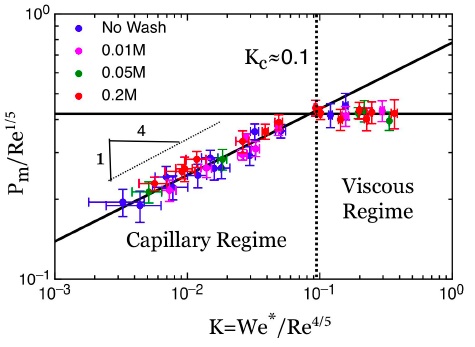Liquid Metal Impact
Monday, March 4, 2013
Normal impact of liquid metals is important for a wide variety of industrial processes and applications, including electronic fabrication and thin film coating. Typically, precise control of the drop spreading is desired, in particular for processes that require reproducible and predictable behavior to build up layers from successive drop impact events. However, except for mercury most liquid metals develop an oxide skin when exposed to air, resulting in non-Newtonian behavior. One of the direct consequences is that the oxide layer consumes a portion of kinetic energy and thus deviates their spreading dynamics from ordinary liquids in the impact. Also, oxidized liquid metals can generally form non-spherical drops since the surface skin not only prevents contact between air and the bulk of the material but also the minimization of the surface energy. This paper presents a detailed experimental study of how the presence of an oxide skin controls the dynamics of liquid metals impinging onto a solid surface.
We investigated the normal impact of eutectic gallium-indium (eGaIn) drops under different oxidation conditions. The image collage above shows stills from a high-speed video of the impact process (time increases from top to bottom, t=0 is the moment of impact). The three columns show the behavior for three different oxide skin thicknesses, decreasing from left to right by tuning the concentration of HCl the eGaIn was washed with.
-
• Qin Xu, Eric Brown, and Heinrich Jaeger, “Impact Dynamics of Oxidized Liquid Metal Drops”, pdf file
Our findings show how the presence of the oxide skin leads to two different dynamical regimes. At low impact velocity (or low Weber number), eGaIn droplets display strong recoil and rebound from the impacted surface when the oxide layer is removed. In addition, the degree of drop deformation or spreading during the impact is controlled by the oxide skin. We show that the scaling law known from ordinary liquids for the maximum spreading radius as a function of impact velocity can still be applied to the case of oxidized eGaIn if an effective Weber number We* is employed that uses an effective surface tension factoring in the yield stress. In contrast, no influence on spreading from different oxidations conditions is observed for high impact velocity. This suggests that the initial kinetic energy is mostly damped by bulk viscous dissipation.
The results from both regimes can be collapsed in an impact phase diagram controlled by two variables, the maximum spreading factor P_m, given by the ratio of initial to maximum drop radius, and the impact number K = We*/Re^(4/5), which scales with the effective Weber number We* as well as the Reynolds number Re. The data exhibit a transition from capillary to viscous behavior at a critical impact number Kc ~0.1, as shown below.

